It’s extremely thrilling when the World Champion plays your favorite opening. However, it’s somewhat less than thrilling when he loses with it. So it was both exciting and discouraging to read that Magnus Carlsen had played the Bird Variation of the Ruy Lopez last month at the Olympiad and had been upset by a player rated 200 points below him.
I guess maybe I should be happy because if he had won, then everybody would start playing the Bird and I would suddenly have to learn a lot of new theory. Since he lost, the universal conclusion of the commentators seems to have been, “That opening sucks.” So nothing will change and I can go on playing the Bird to my heart’s content against White players who will not be prepared for it.
Well, let’s see what happened and whether the Bird is really so awful.
Ivan Saric – Magnus Carlsen
1. e4 e5 2. Nf3 Nc6 3. Bb5 Nd4 4. Nxd4 ed 5. Bc4!?
In my series on the Bird, I called this variation, along with the variations where White moves the bishop on move four, the Bashful Bishop Variation. Historically they have not been considered the main line for White, but actually this line does “contain a drop of poison,” as annotators like to say. White realizes that Black’s main road to equality in the Bird Variation passes through … c6 and … d5. Therefore he hastens to take control of the d5 square before Black can contest it.
Another good argument in favor of 5. Bc4 is that in the three games I have played against GM’s with the Bird, two of them have chosen this approach. By contrast, I have never seen any player under 2000 choose the Bashful Bishop Variation. Amateur players learn principles like “Don’t move the same piece twice in the opening,” and they don’t know when or why to overrule those precepts.
It’s possible, though, that after the Saric-Carlsen game, 5. Bc4 might become the main line. It’ll be interesting to see whether it starts to come up more often in my games.
5. … Nf6!
Carlsen plays it correctly so far. I mentioned in my blog post that the computer recommends 5. … d5 but I do not understand it. That assessment still holds. In fact, 5. … d5 would probably transpose to the game, which did not work out well for Carlsen.
6. O-O!
Also a good, enterprising move and undoubtedly best. Now Carlsen played 6. … d5?! and quickly got in trouble. However, if he had read my blog he would have played 6. …. Nxe4!
Let me show you two positions to explain why.
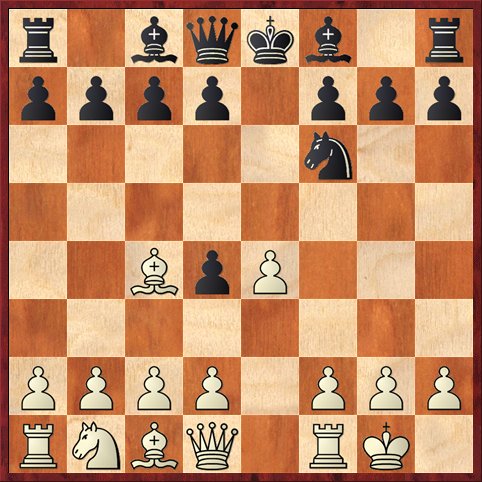 FEN: r1bqkb1r/pppp1ppp/5n2/8/2BpP3/8/PPPP1PPP/RNBQ1RK1 b kq – 0 6
FEN: r1bqkb1r/pppp1ppp/5n2/8/2BpP3/8/PPPP1PPP/RNBQ1RK1 b kq – 0 6
Position after 6. O-O. Black to move.
This is the position in our game.
FEN: r1bqkb1r/pppp1ppp/2n2n2/8/2BpP3/5N2/PPP2PPP/RNBQ1RK1 b kq – 0 5
This is the position in the Two Knights Defense after 1. e4 e5 2. Nf3 Nc6 3. Bc4 Nf6 4. d4 ed 5. O-O.
As you can see, there’s not a whole lot of difference between them. In the Saric-Carlsen position, White has a pawn on d2, and the knights on f3 and c6 are off the board.
In the Two Knights position, Black is considered to have two good moves: 5. … Bc5 (the Max Lange) and 5. … Nxe4 (the anti-Max Lange). Now I know that 5. … Nxe4 looks incredibly dangerous and greedy, grabbing a pawn and opening up lines in the center. But it’s completely sound. It has 150 years of theory behind it.
Do the small differences I pointed out change the assessment of 5. … Nxe4? Well, if we look at the main line, which goes 6. Re1 d5 7. Bxd5 Qxd5 8. Nc3!, we see in fact that there is a huge difference that works in Black’s favor. Namely, if White had a pawn on d2 he would no longer have a pin on the d-file, and the key move 8. Nc3 would be completely unplayable for White!
So, in fact, Black should play 6. … Nxe4 in the Saric-Carlsen position. As I wrote several years ago, I have played one tournament game with this move, which worked out very well for me after 7. Re1 d5 8. Bxd5 Qxd5 9. d3 Be6 10. de Qd7. See my earlier post for further discussion. Conclusion: White cannot punish this move in his “normal way” from the Two Knights, and so he has to come up with something different.
In fact, there are a whole lot of possibilities for White after 6. … Nxe4. There’s 7. Re1. There’s 7. d3. There’s 7. Bd5. All of these are interesting and unexplored, and probably lots of fun. I don’t want to discourage anyone from taking a l0ok at them, and if you find a way for White to get a clear advantage I’ll be the first person to take my hat off to you.
However, today I’ll just talk about the continuation recommended both by the computer and by GM Balogh Csaba, who commented on this game for Natalia Pogonina’s blog:
7. Bxf7+! Kxf7 8. Qh5+ g6 9. Qd5+ Kg7 10. Qxe4 Qf6 11. d3
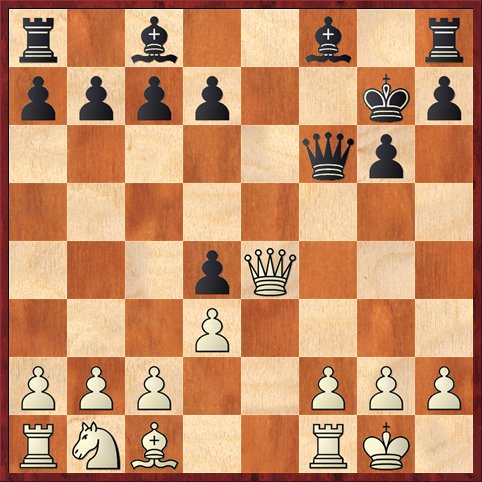 FEN: r1b2b1r/pppp2kp/5qp1/8/3pQ3/8/PPPP1PPP/RNB2RK1 w – – 0 11
FEN: r1b2b1r/pppp2kp/5qp1/8/3pQ3/8/PPPP1PPP/RNB2RK1 w – – 0 11
Position after 11. d3. Black to move.
If Csaba is right, and I see no reason to think otherwise, this is really the crucial position of the Bashful Bishop Variation. Csaba says that White “has a stable advantage due to the better pawn structure and the weakened position of the Black King.” He recommends that White should continue with Bf4 and Nd2, which I’ll agree are pretty obvious moves.
Although you should not trust my judgement over a grandmaster’s, let me point out a couple reasons why I do not think it is so cut and dried, and Black players should not lose heart.
First, what about the difference in the pawn structure? Yes, White has a kingside pawn majority, and Black’s majority on the queenside does not have an equal ability to create a passed pawn. But that’s also true in other variations of the Ruy that are considered OK for Black, such as the Exchange Variation and the mega-popular Berlin Variation. So that in itself is not a decisive advantage for White; it’s merely a reason that Black should avoid a king-and-pawn endgame. The other defect in Black’s pawn formation is the doubled d-pawn. But, as always in the Bird Variation, it is not as bad as it might seem. It has a real cramping effect on White’s position. So my conclusion is that the pawn structure at most gives White a very small advantage.
What about Black’s weakened king position? There I have to disagree with Csaba. By hook or by crook, Black has actually gotten his king to a pretty safe place. After the dark bishop moves and the rook comes to f8, I think Black’s king is fine. Really, the position needs more practical tests to be sure.
And what about the factors Csaba didn’t mention? First there are the two bishops, which could give Black quite a bit of compensation for the aforementioned weaknesses. Second, that queen on e4, seemingly the pride and joy of White’s position, could become a target after Black plays … Bb7, or … Bd7-c6, or brings a rook to the e-file, or plays … c6 and … d5. In all of these natural plans, Black will gain a free tempo by kicking the queen.
Now let’s get down to concrete analysis. Csaba says that White’s plan is to play Bf4 and Nd2. Rybka is actually not such a fan of Bf4 right away. If 11. … Bc5 12. Bf4 d6 13. Nd2 Bd7! Black takes advantage of the fact that the bishop on f4 is defended only by the queen. White can’t play 14. Qxb7 because the bishop drops off. As a result, Black completes his development with no interruption and has moves like … Bc6 coming up.
The computer is actually more concerned about 12. Nd2 immediately. I think the point of this is precisely to interfere with Black’s development and put pressure on points like d4, g5, and h6 before Black is ready to defend. Let me give an example of bad play by Black: 11. … Bc5 12. Nd2 c6? (seems natural!) 13. Nb3 d5 14. Qf4!
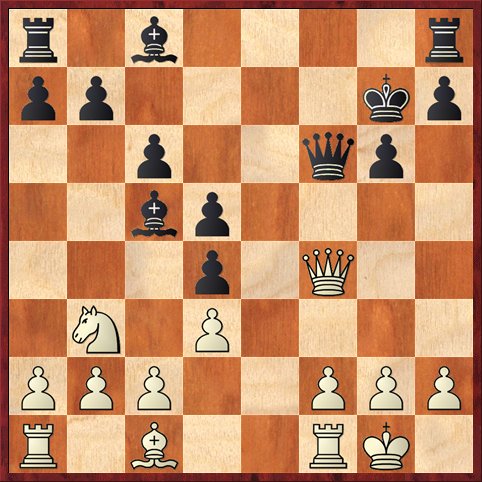 FEN: r1b4r/pp4kp/2p2qp1/2bp4/3p1Q2/1N1P4/PPP2PPP/R1B2RK1 b – – 0 14
FEN: r1b4r/pp4kp/2p2qp1/2bp4/3p1Q2/1N1P4/PPP2PPP/R1B2RK1 b – – 0 14
Position after 14. Qf4. Black to move.
At first this seems kind of harmless for Black, but then you realize that it’s not. The queen trade 14. … Qxf4 15. Bxf4 simply loses a pawn, because Black has to move his bishop and then White plays Be5+. If Black doesn’t trade queens, then White gets to play Qh6+ and this is really not good for Black, because Black doesn’t get to finish his “castling by hand.” I would venture to say that this line is exactly the sort of thing Csaba had in mind when he wrote about Black’s bad formation and weakened king position.
But Black can do better! I’ll suggest two possibilities. First, the computer suggests (after 11. … Bc5 12. Nd2) 12. … d6 13. Nf3 h6. Black is trying to defend his weaknesses. But the computer gives White a half-pawn plus, and I agree — this position is not at all comfortable for Black.
Therefore I conclude that 11. … Bc5 was a mistake in the third diagrammed position, and the better move is the surprising 11. … Bd6!
Why do we want to play this move?
- It stops Csaba’s Bf4 dead in its tracks.
- It stops Rybka’s Nd2 dead in its tracks.
- Rybka thinks that it’s Black’s best move!
- The bishop is in many lines better posted on d6 than on c5, because on c5 it’s just a tall pawn. On d6 it eyes the h2 pawn.
- It does to White what White wanted to do to Black: it confuses his development. If the knight isn’t going to d2 and the bishop isn’t going to f4, then what exactly is White’s plan? How does he get his queenside pieces out?
Why don’t we want to play this move?
- It gets in the way of the d-pawn and therefore slows down the development of Black’s queenside.
- With Black’s queenside pieces out of action, maybe White can whip up a quick kingside attack with 12. f4.
Let me try to convince you that the “do’s” are more compelling than the “don’t’s.”
After 11. … Bd6 Rybka still thinks that White’s best move is 12. Nd2. But now Black plays 12. … Qe5! (threatening mate on h2) 13. Qxe5 Bxe5 14. Nf3 d6.
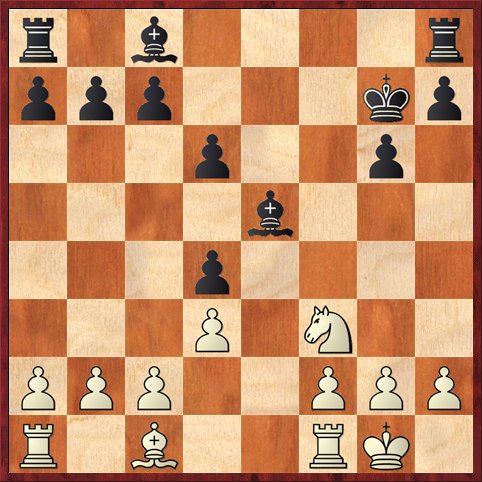 FEN: r1b4r/ppp3kp/3p2p1/4b3/3p4/3P1N2/PPP2PPP/R1B2RK1 w – – 0 15
FEN: r1b4r/ppp3kp/3p2p1/4b3/3p4/3P1N2/PPP2PPP/R1B2RK1 w – – 0 15
Position after 14. … d6. White to move.
All I can say here is, “Are you kidding me? Is this what Black is supposed to be afraid of?” I see two possibilities here. One is that White will trade on e5. In that case the position looks equal to me. Bishops of opposite colors, no open files, no pawn majority on the kingside for White. Black does have a backward pawn on e5, but even if worst comes to worst and White wins that pawn, the likely consequence is mass rook trades on the e-file and a drawn opposite-color bishop endgame.
The other possibility is that White will not trade on e5. In that case, Black remains with the two bishops and a space advantage, and I don’t mind that one bit. There is still a slight weakness of the pawn on d4, but what concrete plan does White have to exploit this?
Conclusion: I’m happy to play this line for Black. To me, this is an example of a queen trade that is benign for Black, as opposed to diagram four where the queen trade worked out quite badly for Black.
Finally, in the third diagram position, what about 11. … Bd6 12. f4? This was the reason I initially rejected 11. … Bd6, until I saw that Rybka was not concerned. Black just continues 12. … Rf8, finishing his castling by hand. After this, the silicon monster says, Black will calmly play 13. … Rb8, 14. … b6, and 15. … Bb7.
I think that detailed analysis would probably lead us too far afield, but as a general rule White has many opportunities in the Bird to play f4, but if he does so before bringing his queenside pieces into play, the attack almost always turns out to be more smoke than fire. If White should continue with f5,there is actually no threat because the f-pawn will be pinned. If he doesn’t continue with f5, the pawn at f4 actually gets in the way of the bishop. If the bishop goes to d2 it gets in the way of the knight. If the knight goes to d2 it gets in the way of the bishop and the f4 pawn drops. As I said, Rybka was not at all concerned about 12. f4 and actually starts showing a tiny plus for Black.
I apologize for this very long post, but it’s not every day that a World Champion plays your opening! I also apologize for the fact that a lot of the lines are computer analysis. However, I’ve tried to supplement the computer analysis as much as possible with my own point of view derived from playing many games in other lines of the Bird. It remains a very tricky variation to play and evaluate, because it forces you to take a critical look at adages like “don’t move the same piece twice in the opening” or “doubled pawns are a weakness.” It’s a very chameleon-like variation. That’s why I like it!
P.S. I haven’t written at all about what happened in Saric-Carlsen after 6. … d5. In short, Carlsen sacrificed two pawns and got pretty good compensation, but it wasn’t enough and Saric played absolutely perfect, lights-out chess. The rest of the game is well worth going over, and it’s a great accomplishment for Saric.
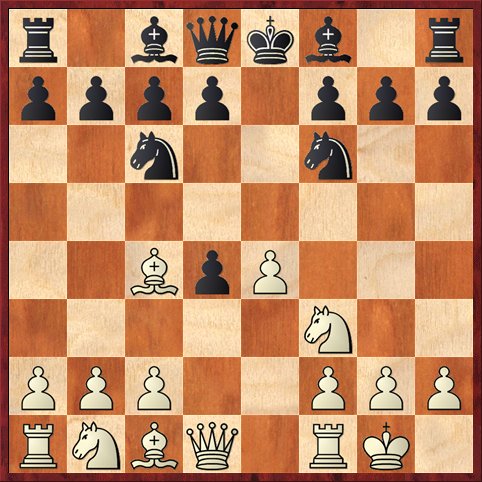



{ 2 comments… read them below or add one }
hi!
good post!
if you love chees game, you must try the game by ketchapp
https://play.google.com/store/apps/details?id=mobi.ketchapp.warofchess
In your “Are you kidding me”-position, what are you playing against 15.Ne5 de 16.f4 ?
Doesn’t look like much fun for black to me. In fact I can’t find a variation in which black doesn’t lose a pawn immediately.
But presumably Rybka has something up its sleeve …